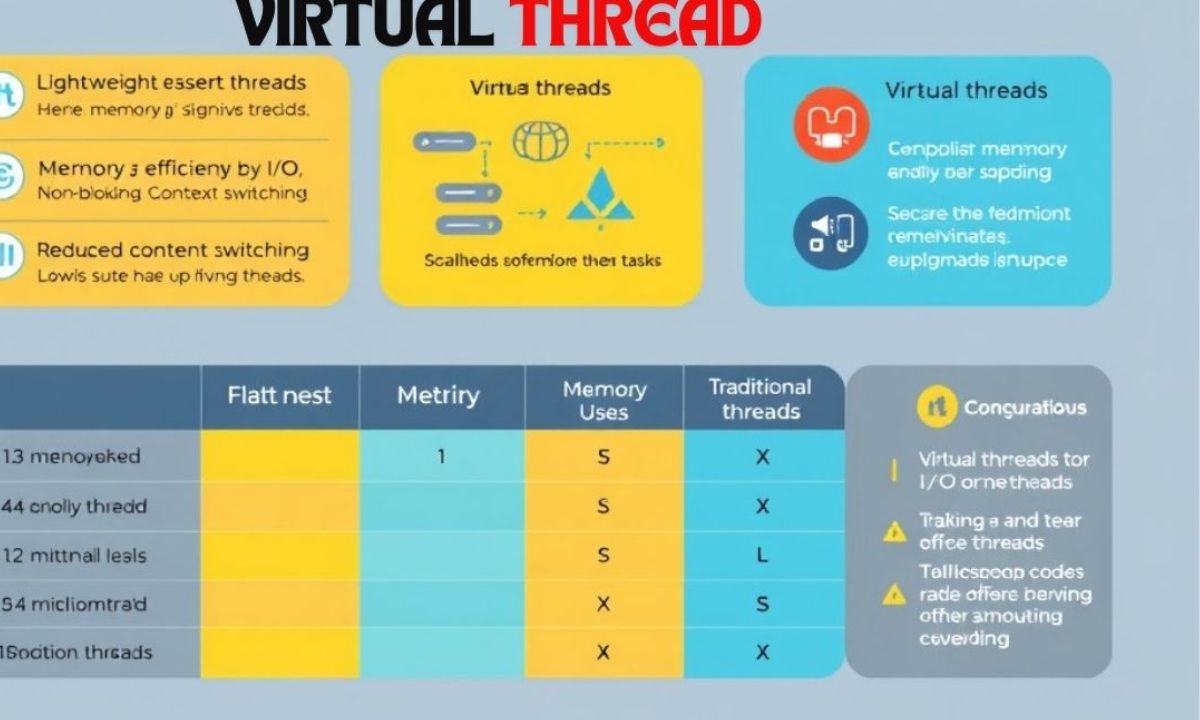Virtual threads, introduced in Java through Project Loom, promise to revolutionize concurrency in software development.
They are lightweight and managed by the Java Virtual Machine (JVM), allowing developers to create thousands of threads without overwhelming system resources.
This innovation aims to enhance performance, particularly in high-currency applications. However, understanding their capabilities and limitations is crucial to leveraging their full potential effectively.
The Promise of Virtual Threads: What the Buzz Is All About
The buzz around virtual threads is primarily due to their potential to solve long-standing issues in software development.
They promise memory efficiency, faster context switching, improved scalability, and a simplified concurrency model. Each of these aspects contributes to their appeal in modern application development.
Memory Efficiency
Virtual threads consume significantly less memory than traditional threads. This efficiency arises from their lightweight nature. Each virtual thread requires a small stack, often just a few kilobytes.
Traditional threads, in contrast, can consume megabytes of memory. As a result, applications can handle thousands, or even millions, of virtual threads without running into memory limitations.
Faster Context Switching
Context switching is the process of saving and restoring the state of a thread. Traditional threads, managed by the operating system, incur considerable overhead during context switching.
Virtual threads reduce this overhead because they are managed by the JVM. This leads to faster context switching, especially beneficial in applications with high I/O operations.
Improved Scalability
The scalability of virtual threads is another significant advantage. Traditional threading models often hit resource limits, making it difficult to scale applications.
Virtual threads, however, allow for the creation of a massive number of concurrent threads.
This scalability is crucial for modern applications like web servers that must handle many simultaneous requests.
Simplified Concurrency Model
Developers often find concurrent programming complex and challenging. Virtual threads simplify this model.
They allow developers to write code in a synchronous style while achieving asynchronous performance.
This approach reduces the complexity associated with callbacks and reactive programming frameworks.
Real-World Performance: When Virtual Threads Excel

Virtual threads excel in several scenarios, particularly involving high concurrency. They are ideal for I/O-intensive applications, high-concurrency systems, and microservice architectures.
I/O-Intensive Applications
Virtual threads shine in applications that frequently wait for external resources. Examples include web servers and database connections.
In these scenarios, virtual threads can handle many simultaneous connections without blocking, improving overall throughput.
High-Concurrency Systems
Applications designed to handle thousands of concurrent users benefit from virtual threads. For instance, chat applications and gaming servers require rapid response times and the ability to manage numerous connections.
Virtual threads provide the necessary infrastructure to support these demands effectively.
Microservices and Serverless Architectures
Microservices architectures thrive on lightweight and scalable solutions. Virtual threads fit perfectly into this model, enabling services to manage multiple tasks concurrently.
This capability aligns well with serverless architectures, where efficiency and resource utilization are critical.
The Limitations of Virtual Threads: When They Fall Short

Despite their advantages, virtual threads also have limitations. They may not be suitable for CPU-bound applications, blocking operations, or scenarios where JVM overhead becomes a concern.
CPU-Bound Applications
Virtual threads do not perform as well in CPU-bound applications. Traditional threads are more efficient for tasks requiring significant processing power.
Since virtual threads are scheduled by the JVM, they may not leverage CPU resources as effectively as traditional threads.
Blocking Operations
Blocking operations can hinder the performance of virtual threads. When a virtual thread is blocked, it can prevent other threads from executing.
READ THIS ARTICLE: Discount Code TTweakFlight: Unlocking Travel Savings
This issue can arise in scenarios where operations require waiting for resources, thereby reducing overall throughput.
JVM Overhead
While the JVM offers many advantages, it also introduces some overhead. Virtual threads rely on the JVM for management, which may lead to performance penalties in certain situations. Understanding this trade-off is essential for developers considering virtual threads.
Frequently Asked Questions?
What are virtual threads?
Virtual threads are lightweight threads managed by the JVM, designed to simplify concurrency in Java applications.
How do virtual threads improve memory efficiency?
They use significantly less memory than traditional threads, allowing for the creation of many concurrent threads without resource exhaustion.
In what scenarios do virtual threads excel?
Virtual threads excel in I/O-intensive applications, high-concurrency systems, and microservice architectures.
What are the limitations of virtual threads?
They may not perform well in CPU-bound applications, blocking operations, or when JVM overhead becomes a concern.
How do virtual threads simplify concurrency?
They allow developers to write synchronous code that achieves asynchronous performance, reducing complexity in code maintenance.
Conclusion
Virtual threads represent a significant advancement in Java’s concurrency model, offering developers enhanced performance and scalability for modern applications.
Their lightweight nature allows for efficient memory usage and faster context switching, making them ideal for I/O-intensive tasks and high-concurrency environments. However, it’s essential to recognize their limitations, particularly in CPU-bound applications and blocking operations.
By carefully assessing these factors, developers can effectively harness the power of virtual threads, simplifying concurrency while improving application responsiveness.














